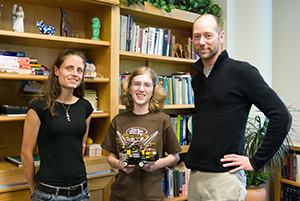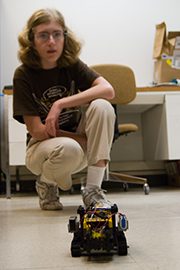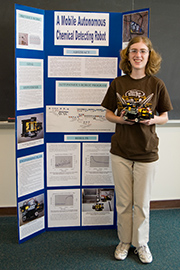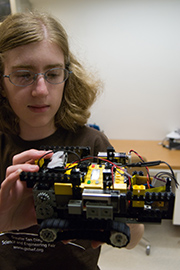|
Inspiring a Passion for Science
Mentoring by maverick UCSD chemist helps high school student snag top win at state science fair
Ioana Patringenaru | June 8, 2009

Anna Kornfeld Simpson, center, poses with UCSD Professor Michael Sailor, right, and UCSD graduate student Anne Ruminski, left. Sailor and the graduate student helped Anna work on a robot that won the project of the year award at this year's California State Science Fair.
The first time Anna Kornfeld Simpson visited Michael Sailor’s lab at UC San Diego, she was just one of a group of high school freshmen who had come to learn more about the researcher’s work. But while her classmates asked Sailor about rainbows, Anna asked whether he used a specific kind of crystal and how it worked.
Anna’s first visit led to a long-term stint in Sailor’s lab starting the following summer. There, she developed a robot that won the Project of the Year award in the senior division last month at the California State Science Fair. Working with students like Anna is part of UCSD’s public service mission, the UCSD researcher said.
“We’re chartered to educate the sons and daughters of California," Sailor said.
Anna developed in Sailor's lab a robot that won the Project of the Year award in the senior division last month at the California State Science Fair. Now a junior at Patrick Henry High School in the San Diego Unified School District, Anna said her time at UCSD was essential to help her win the trophy. “It was inspiring to see how research is done on a daily basis,” she said.

Anna demonstrates how her robot works.
A higher education institution can’t replace what high schools do; but scientists can serve as role models for gifted students who can benefit from being on a college campus, Sailor said.
“I want to find these key people and make a difference in their life,” he said.
For Sailor, working with high school students is important on another level too. One of his first mentors was his high school chemistry teacher, who gave him access to his lab after school. “That experience really brought home the importance of mentoring to me,” he said.
Having high school students, and undergraduates, in the lab also benefits graduate students, Sailor said. Everyone in his lab knows he expects them not only to get along with professors and peers, but also to learn how to teach and mentor others.
Anna was paired with graduate student Anne Ruminski. The sixth-year doctoral student said she was impressed by the high school junior’s ability to focus and her in-depth knowledge. Before she got ready for the state science fair, Anna gave her presentation to grad students in Sailor’s lab. “I think that takes a lot of guts for someone that age,” Ruminski said.

Anna and her award-winning robot and science fair poster.
Anna also worked with Travis Wong, a first-year grad student, who helped her design the electronics behind her award-winning robot. Wong said he was impressed by her ability to map out the circuits’ different components. She just needed help establishing the connections between them, he said. “She knew almost exactly what she needed,” Wong said.
It was inspiring to see how graduate students stick with their research, even when experiments don’t work, Anna said. “That really helped inspire me to persevere when my circuit wouldn’t work, and wouldn’t work, and wouldn’t work,” she added.
Sailor is one of the leading researchers in his field, perhaps best known for the "smart dust" technology developed in his lab. The microscopic particles, built on a nanoscale, can for example be loaded with medicine, to be delivered to a specific target area within the body. They can also be programmed to act as sensors. Sailor's lab also developed chips that change colors when exposed to certain chemicals. They could be used to collect environmental data, detect toxic spills and even chemical attacks.
Anna’s robot, which is mostly made up of LEGOs, is built around one of these chips. Anna came up with the idea of putting the chip on an autonomous robot, Sailor said. But her robot’s sensors were at first too crude and couldn’t detect small amounts of chemicals. Anna had to re-design the circuitry and program it herself. This is the kind of work that even graduate students would struggle with, Sailor said. Her robot finally worked. It now sounds an alarm every time it encounters a chemical it deems dangerous, such as ethanol, and then backs up.

Anna shows a detail of her robot's inner workings.
Anna said she has been fascinated with robotics since fifth grade, when she started building LEGO robots. She also said she was captivated by NASA’s Mars rovers and the idea that robots could reach places that humanity couldn’t yet explore. She likes robotics because it brings together several disciplines, including computer science, engineering and in this case, chemistry, she added. One of her dreams is to build a robot that will go to Mars, she said.
Even before robotics, Anna liked trains and did well in math, said her father, Thomas Simpson, a physicist. The two used to work together on Anna’s LEGO creations. Simpson set up an after-hours robotics club for Anna and her classmates. He contacted Sailor to ask him for a tour of his lab for the students. Sailor agreed.
At the end of the visit, the UCSD researcher pulled Simpson aside and asked him to bring back his daughter to the lab when she had a project to work on. Anna has now been coming regularly to UCSD for two years. In the meantime, she won various awards at science fairs, including a $50,000 scholarship at the Intel International Science and Engineering Fair last month, as well as $10,000 at the California State Science Fair. She plans to use the money for college, she said.
This summer, she will attend the Massachusetts Institute of Technology for six weeks, taking classes with other high school juniors and working on a project with college professors and industry scientists. She hopes to come up with her project for next year’s science fair season, she said.
Having students like Anna on a college campus can reap unexpected benefits, Sailor said. For example, the Jacobs School of Engineering just hired Andrea Tao, a Harvard and UC Berkeley alumna, as a faculty member. She used to work in Sailor’s lab when she was in high school.

|